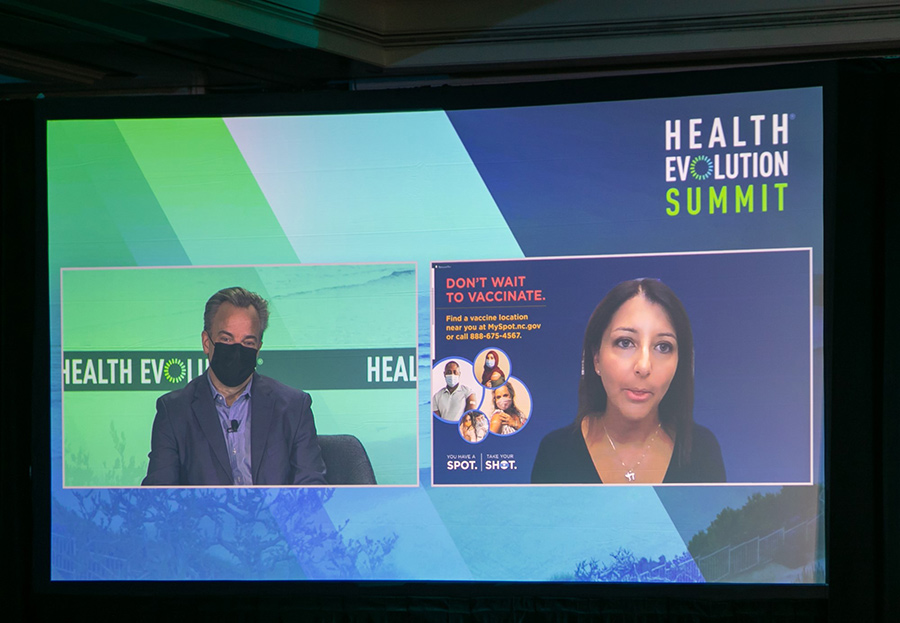Public-private sector partnership was top of mind from leading federal and state government officials at the Health Evolution Summit 2021. But while the government officials discussed the necessary alignment needed between stakeholders in response to the COVID-19 pandemic, the need for collaboration will extend into the post-pandemic future.
“Health system reform and health system transformation need innovators. We need capital investment and new ideas and strategies. And the role of CMMI is to help clear the path for innovators and clear some of the regulatory hurdles that might be a barrier to good ideas and to be able to test those ideas. And in that way, we can help set the stage for that investment and those new ideas,” said Liz Fowler, PhD, Director of the Center for Medicare and Medicaid Innovation (CMMI).
Fowler was joined by Meena Seshamani, MD, PhD, Deputy Administrator and Director of the Center for Medicare, Mandy Cohen, MD, Secretary of the North Carolina Department of Health and Human Services, and moderator, Mark McClellan, MD, PhD, Robert J. Margolis Professor of Business, Medicine, and Policy, and founding Director of the Duke-Margolis Center for Health Policy at Duke University.
Fowler said she wants it to be easier for health care organizations to partner with CMMI to create new models of care, something the agency has been criticized for in the past. She added that better multi-payer alignment with private payers, purchasers, other public payers like departments of health at the state level of Medicaid agencies is vital to CMMI’s overall strategy.
“A lot of CMMI is built on the idea of public-private collaboration. The idea behind this innovation is that we learn from the private sector, and we try to take that and see what can be used and implemented and expanded in the public sector,” Fowler said. But while she is bullish on this kind of collaboration, particularly with regards to innovators looking to partner with federal and state agencies, she cautioned against those who are investing into this space for the wrong reasons.
“We need investors who are interested in health care because they’re passionate about helping patients or improving the health system. Not those who are looking for a quick buck and figured out how to game the system,” Fowler added.
Federal government recommits to value-based care
Both Fowler and Seshamani were optimistic on the federal government’s commitment to using these value-based care models to advance primary care, address social drivers of health, lower costs, and create sustainable models. At the Summit, Seshamani announced results for ACOs participating in the Medicare Shared Savings Program in 2020. In total, ACOs in that program earned performance payments totaling nearly $2.3 billion while saving Medicare approximately $1.9 billion.
“For us on the Medicare side…we’re going to be doing breakdowns of this performance in the Shared Savings program, looking at diversity of the beneficiary population, looking at geography, vulnerable populations,” Seshamani said. “How do we get more beneficiaries involved in these holistic models? And how do we better align incentives and align our programs and metrics across the continuum…and encourage movement along this value-based care continuum with an eye towards advancing health equity, driving that high-quality person-centered care, and really looking at affordability and sustainability?”
Like Fowler, Seshamani sees a lot of private-public opportunities within the Medicare Advantage program to address the social determinants of health. She said many Medicare Advantage plans have been innovating with options such as meal delivery and transportation. She also sees opportunities within Medicare programs to create better transparency, plan navigation, language accessibility and beneficiary support. But it goes beyond Medicare, Seshamani noted, as Medicaid and the ACA marketplace can be other areas for shared learning between public and private sector entities.
“We need to make sure that there is accountability and value in what is being provided for beneficiaries. This means better data transparency so that we can know where the money is going, how it is being used, what is effective, what is not effective. That’s part of the continuous learning that all of us have to do in health care, because unless I am missing something, healthcare is very complex, and there is not a silver bullet,” Seshamani said.











